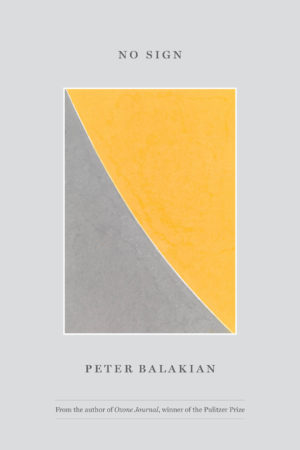No Sign
by Peter Balakian
reviewed by Hovig Tchalian
The latest collection of poems from Armenian-American poet, essayist, and memoirist Peter Balakian carries the suggestive title No Sign. What are we to make of this? No sign … of life, of love, of civilization? Or, alternatively, no sign … as in nothing meaningful signified, a set of empty signifiers? What does Balakian’s collection itself index?
Judging from Balakian’s prior writings and his long-standing vocation as writer-cum-academic, I would venture that the title embraces both the colloquial and the academic meanings. As a coherent volume, the poems index Balakian’s archetypal themes of dislocation, suffering, and loss. As a varied collection, they reflect a decade of global discord and upheaval. Together, the poems speak to each other in strange and unexpected ways.
All of that is as it should be; the collection’s primary aim seems to be to explore the mystery, or the illusion, of wholeness that makes life bearable, livable. But the collection also relentlessly, almost obsessively, reminds us of the gaping hole at the center of life, from which we need to relentlessly avert our gaze.
The collection is divided into four sections, each of which directly or indirectly indexes that existential void. The first poem in the first section, “History, Bitterness,” traces the crossing paths of Miles Davis, Louis Malle, and James Baldwin through a phone conversation the speaker and his uncle have with Baldwin, conjoining them with repeated references to history’s bitterness (“the war in Algeria is daily acid in the river”), its emptiness (“sour scent of empty wine bottles”), its loneliness (“I knew Baldwin’s heart went hollow”), and its anonymity (“no name in the street”).
The first poem in the second section, “Eggplant,” a meditation on a dish made by the speaker’s mother, is likewise haunted by the emptiness of historical forgetting:
when the fog of the riverbank
rose like a holy ghost
[ … ]
and summer evenings
came with no memory
The poem then circles back to bitterness: “Shining aubergine—black-skinned / beauty, bitter apple.”
The collection’s final poem, “Walking the Ruined City (Turkish/Armenian Border),” addresses a subject familiar in Balakian’s writing, the Armenian genocide by the Ottoman Turks in the early twentieth century, by retelling a visit to historical Armenian lands. The poem also closes the loop with the repeated images of the empty bitterness of history, extended to an ecological and cosmic scale, building on an earlier reference to black holes in “Yellow Lilies”:
Looking up—a galaxy
is any star skidding into black.A black hole is my love. Who knows what’s
in the next cushion of air.What if a hole is just a Greek urn [ … ] ?
The central trope of repeated calamity in the collection’s title poem is the word noren, a word for Japanese fabric dividers and the Armenian word for “again”: “She: They said goodbye and the noren curtains opened / and the past was a burning city / seen in silence, just images on screens.” This passage leads into a series of quotations of historical calamity from Hiroshima mon amour. The term noren yokes several images together: the empty repetition of history; the separation from the fullness of time; and the unreality of it all, like a film playing endlessly on a flickering screen.
These images point back to the final poem in the second section, “Zucchini.” In what is perhaps the least hopeful of the collection’s metaphors, waking from the nightmare of history leads down yet another dark tunnel: “we wake to find the hallway dark // the small light at the bottom of the stairs.” The series of linked metaphors points directly to the epicenter of the entire collection: the self-referential image at the center of its title poem.
He: refusal to learn from history.
She: Later—after Tet:
“We heard small Buddhist chimes ringing for peace in Hoa Bien.”
Hanoi Nagasaki Saigon Hiroshima
Keep saying it—it will sink in.2019—here—again—no light at the end of the tunnel
no sign—
The list of names stacked together (“Hanoi Nagasaki [ … ] ”) devolving into a staccato of words strung together by dashes (“2019—here—again”) leads to the inevitable conclusion—no light, and no sign of one.
So, here, perhaps, is where the suggestive call of No Sign receives its own response. And while that response may be far from hopeful, it is perhaps the most fitting representation of the present that we endlessly inhabit.
Published on January 24, 2023

